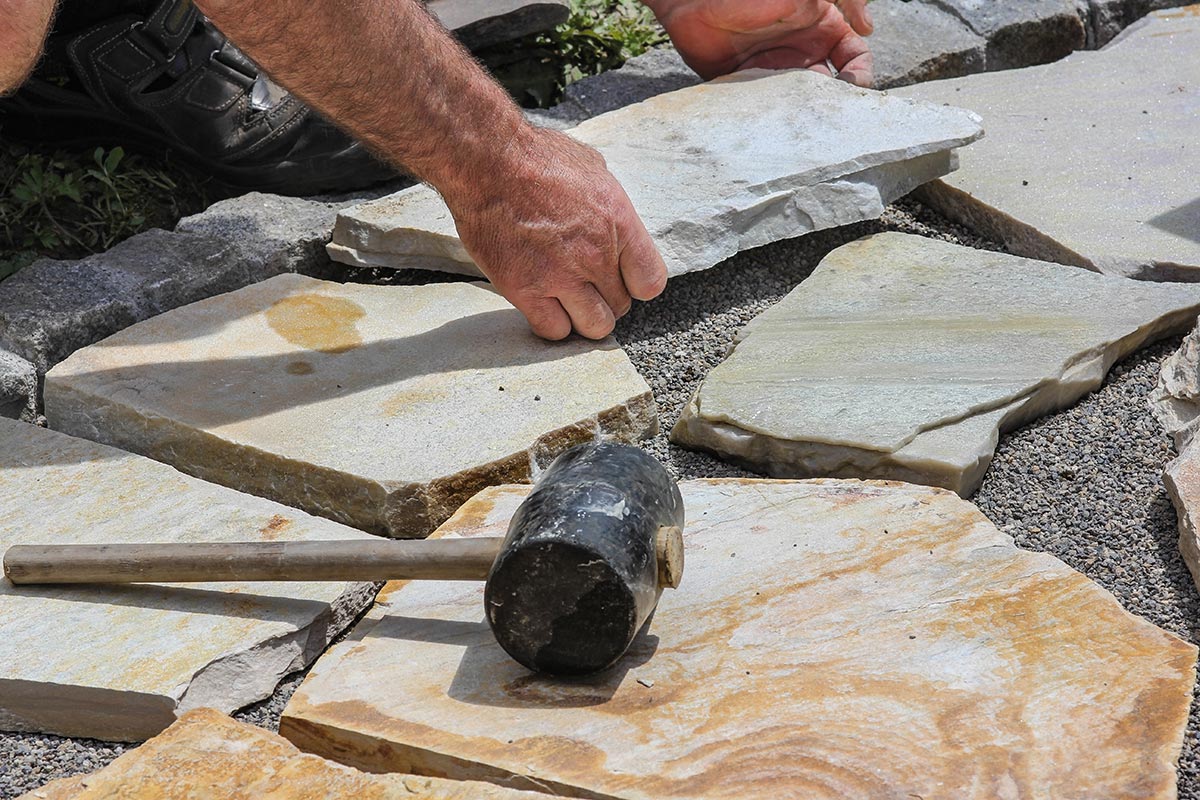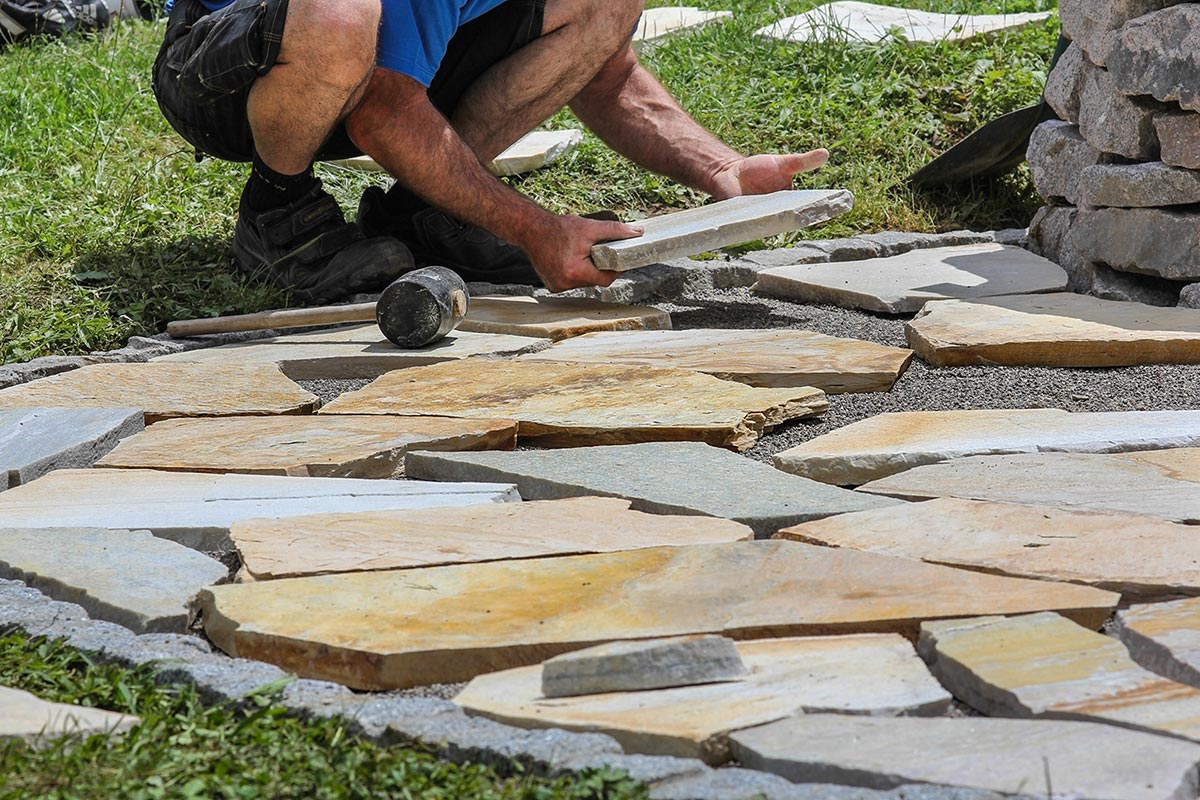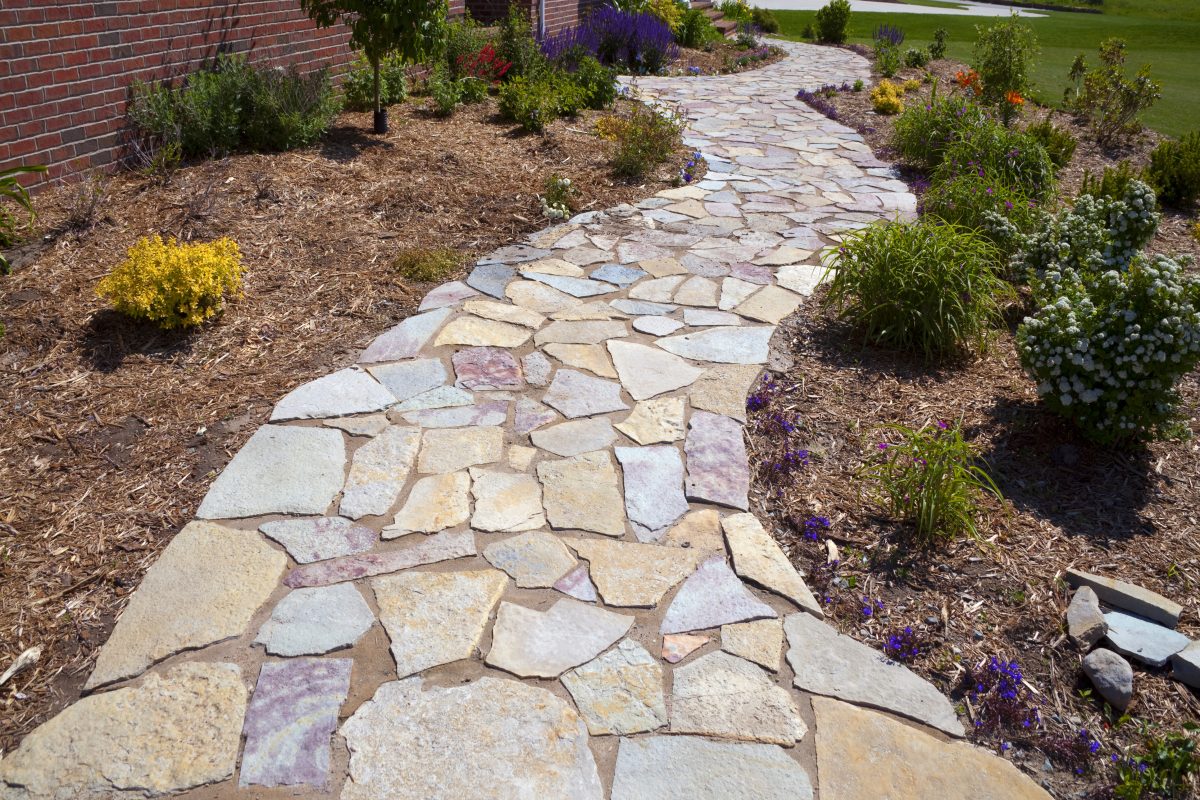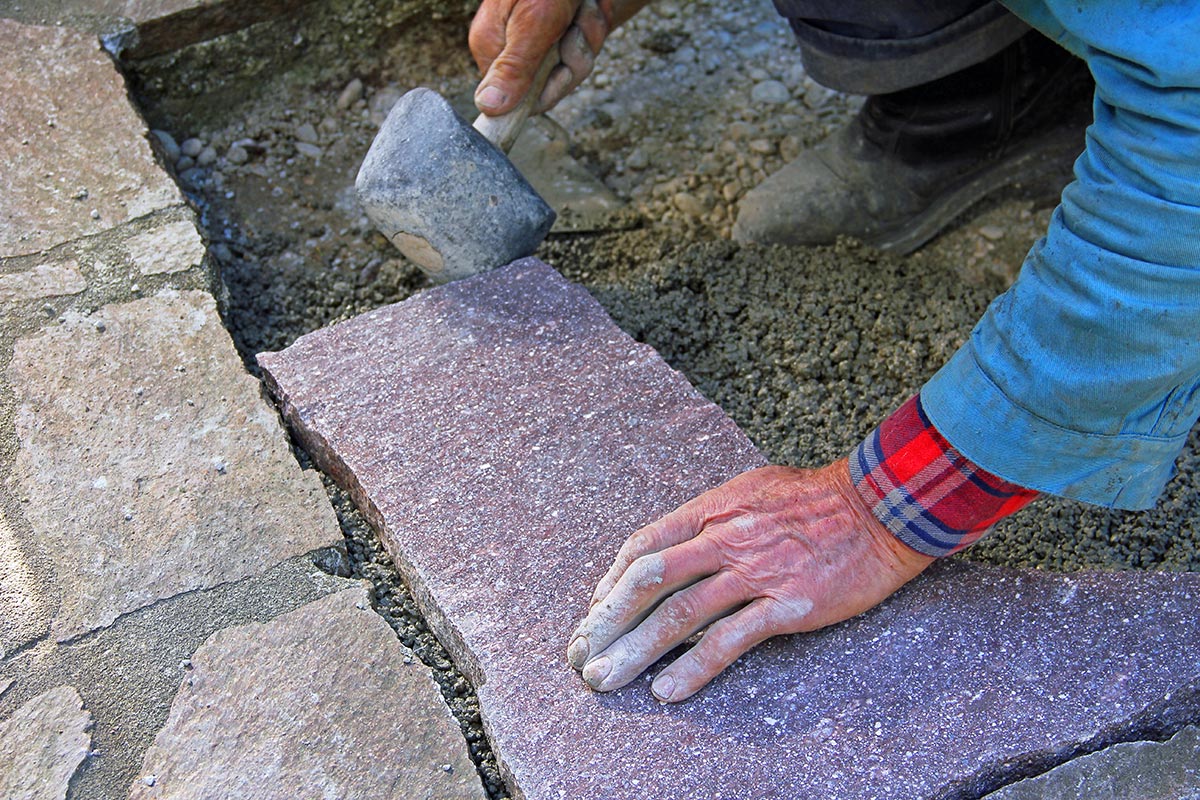Disclosure: We may get commissions for purchases made through links in this post.
Flagstones are generally used to create paths and walkways that guide guests into the house. It is also used on patios because it is a paving surface that looks beautiful and natural to the landscape. With flagstone having many uses for landscaping, you might also be wondering if it can be laid on dirt.
One of the best things about flagstone is that you can easily lay it on dirt. Flagstone is generally heavy, making it the perfect material to lay on dirt surfaces directly. All you need to do is smooth out the soil, place the stones, level them, and fill in the gaps as you piece them together.
Knowing that flagstone can be directly laid on dirt, you may have a few other questions, like how you should lay it down or if there are tips when the ground is uneven. Fortunately, we have researched these topics, so continue reading to learn more about laying flagstones for your walkways or patios.
![Working laying flagstone paver using rubber hammer, Can You Lay Flagstone On Dirt? [With Tips For Laying On Uneven Ground]](https://pavingplatform.com/wp-content/uploads/2022/03/Can-You-Lay-Flagstone-On-Dirt.-800x1200.png)
Can You Lay Flagstone on Dirt?
Flagstones are natural stones that are best used for walkways and patios because of their natural look. It's a popular choice among landscapers because it is very adaptable and can be used as more than just a paving surface. These stones can also be cut in rectangular or square shapes for landscape use, but they are more commonly known for having natural jagged edges, making them the perfect choice for pathways or stepping stones.

One of the advantages of flagstone's adaptability is its heavy weight and acid-resistant properties. These alone make it the perfect stone to lay directly on the dirt without issues. These sedimentary rocks have been used so much for paving that it has been used since the early 1900s.
Generally, flagstones can be easily laid on the dirt with no problem, but most landscapers prefer to add a layer of gravel or sand to provide more hold for the flagstone. Either way will work, and the choice is up to you, but you should consider the quality of the soil you will be laying your flagstones in. This will help you decide whether you'd like to add a sand or gravel layer to your project.
How to Lay Flagstone on Dirt

Laying flagstone on dirt is pretty easy if you follow a few key steps. This process is better done with a few people to help you out because laying out flagstones does take a little bit of digging here and there. Here are the instructions on how to lay flagstone on dirt:
Materials Needed:
- Measuring tape
- Flagstones of your choice
- Sand
- Shovel
- Chisel
- Gravel
- Marking paint
- Line level
- Rake
- Garden hose
- Plate compactor
- Fill material as per your requirement
Instructions:
1. Start measuring and marking
This is the first important step when laying out your flagstone. Measure the area where you will be laying out your flagstones. Mark around the places where you will be laying out the flagstones, ensuring that you will not hit any utility lines when you dig the surface.
Once you have marked your area, you can now begin temporarily laying out the pattern or design of your flagstone. Your measurements should have enough extra space to allow your flagstones to be spaced apart when being laid down.
2. Prepare the dirt
This is an important part when laying your flagstones on dirt. Using a shovel, dig down about 3-6 inches down on the dirt throughout the whole area that you have measured. This is to ensure that your flagstones will be flush with the ground and that they won't become a tripping hazard to your guests.
If you prefer adding an extra base to your flagstone, you can lay a 2-inch thick gravel base on the dirt. Place the gravel evenly and use water to level it on the ground properly.
3. Lay down your flagstone
This is where most of the work is done: laying down the flagstone. When your base is settled and smoothed, lay down your flagstones depending on the pattern and design you have in mind. Make sure to space them about an inch apart for the gaps.
For those who are using naturally irregular flagstones, if you find that some of your flagstones are too big, you can use a chisel and hammer to give your stones a better shape. Make sure not to cut them too small as it will be a lot harder to set them in the final stages.
While laying down your flagstone, make sure that they are level and flush on the base. Make sure that your flagstones do not wobble or shift because this might cause air pockets to appear in your base and cause issues to your pathway or patio in the long run. To ensure that this won't happen, you can pack soil on the edges of your flagstone to set them correctly.
4. Clean up
After placing your flagstones on your chosen area, it is time to clean up the extra dirt on the stones. Use a broom or hose it down with water to clean it off, as excess dirt may cause issues while you fill the gaps of your flagstone path or patio.
5. Fill in the gaps

Finally, you can fill in the gaps of your flagstone with either sand or gravel, depending on your choice. After filling the gaps, use a water mist to set the stone or sand properly. Let it dry and step on them to fully compact your new pathway or patio.
Another option that you can do for filling in the gaps in between flagstones is using ground cover plants between the spaces. Make sure to pack down the soil you will lay your ground cover plants so that all the gaps are covered.
Tips for Laying Flagstone on Uneven Ground

Flagstones should be placed on a sturdy ground base to prevent them from forming gaps and spaces beneath that may cause weeds and other seeds to grow. Unfortunately, not all ground bases are flat and even, and we may find ourselves dealing with an area that needs a little bit more work. While it is a little more complicated than usual, it is not impossible to lay flagstone on uneven ground.
Ensuring that your flagstone is flush against the ground prevents them from becoming a tripping hazard. Uneven ground makes it a little harder to do this, so here are some tips to look into before laying flagstone for your project.
- Work with individual flagstones. Since the ground is uneven, you may need to work with the flagstones one by one to ensure that they will be level when they are permanently placed. Lay your flagstones on individual beds and trace the outline with a trowel or shovel. Dig the dirt twice the depth of the stone and fill it with sand and set it in place. Do this with all your flagstones and check if they are level with each other.
- Utilize your uneven ground by turning it into stone steps. If you are working with a slope, outline the area and excavate it to give you edges where you can place your flagstones. Work on it in increments with each area sloping into the next. This method does not only work for stone steps, but also for multi-level patios.
- Make use of sod or grass [or other ground covering plants] to cover up spaces in between flagstones. Make sure to fill up all the spaces and gaps that you might normally see on uneven ground to prevent weed growth and water damage on your flagstones.
Final Thoughts
Laying down flagstones for your walkways or patios is pretty easy. Flagstones are excellent paving materials that are sturdy and heavy, making them perfect for laying directly on the dirt with no problems. There are multiple ways for laying your flagstones, but if you need to have a little help, consider working with a professional to ensure that your flagstones are set and placed correctly.
Are you looking to learn more about flagstones and other related information? We have a few articles on these topics that might interest you:

![Vibrant Red Paver Stone Path, Can You Spray Paver Sealer? [How To Apply It]](https://pavingplatform.com/wp-content/uploads/2022/04/Vibrant-Red-Paver-Stone-Path-600x400.jpg)
![Properly laid out red pavers for a garden, Can You Tint Paver Sealer? [And How To]](https://pavingplatform.com/wp-content/uploads/2022/04/Properly-laid-out-red-pavers-for-a-garden-600x400.jpg)
